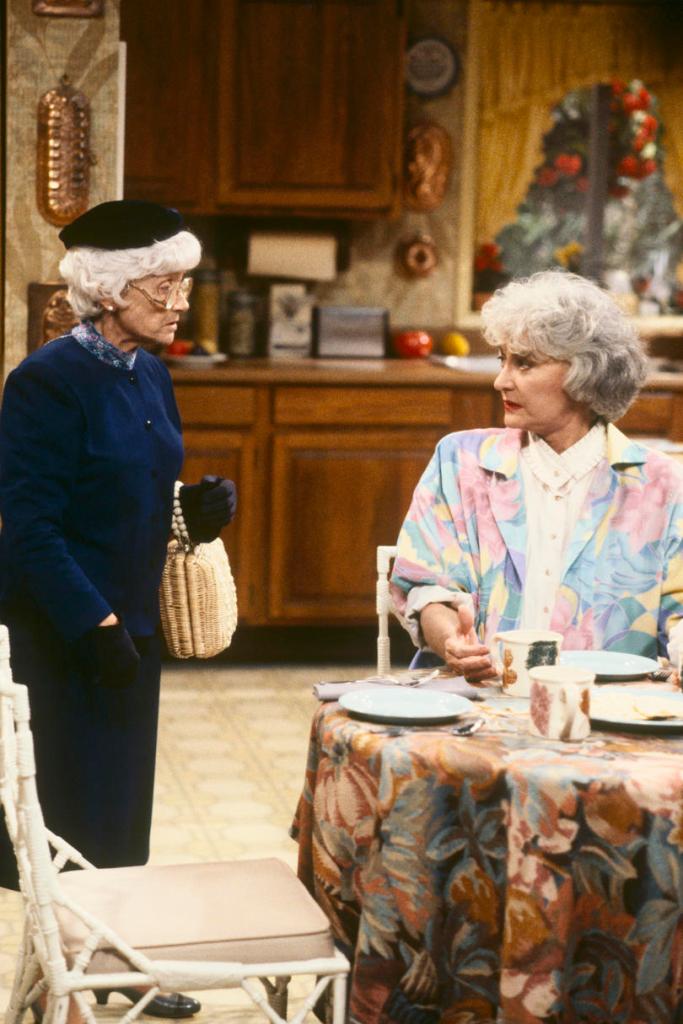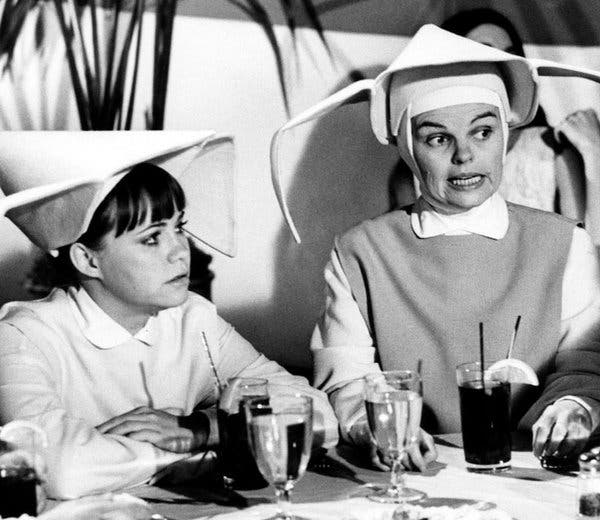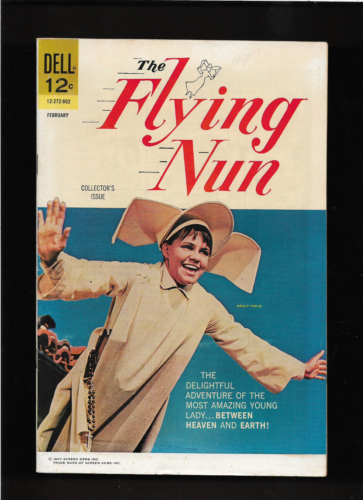We are wrapping up our series, “Girls, Girls, Girls.” At the beginning of the month, we learned about a show that featured four women who spent much of their life together for seven years (Designing Women). Today we end our series with another show that featured a quartet of women that also ran for seven years.
In September of 1985, a new type of sitcom debuted. This show featured four retired women who lived life together, relying on humor to make things work. The show, Golden Girls, was on the air seven years, ending in 1992 and producing 177 episodes. The show was always on Saturday nights with the seventh season moving to an earlier hour.

I read two different versions about the creation of the show, so take your pick. Maybe the truth is somewhere in the middle. One version is that the idea came from Brandon Tartikoff, an NBC executive. When he was visiting his aunt one day, he noticed that she and her next-door neighbor who was her best friend, argued a lot but loved each other. He thought the concept would make a great show.
The other version credits NBC senior vice president Warren Littlefield. He was in the audience when Selma Diamond and Doris Roberts acted in a skit called “Miami Nice,” a parody of the popular Miami Vice. The skit featured old people living in Miami.
Either way, Susan Harris created the show itself, and it was produced by Witt/Thomas/Harris Productions, with Tony Thomas and Harris serving as original executive producers. After the first year, Harris was not as involved with the show, but still oversaw the scripts.

The four main characters are quite different which is probably why the series was so successful. Blanche (Rue McLanahan) owns the house in Miami. Two women, widow Rose Nylund (Betty White) and divorcee Dorothy Zbornak (Bea Arthur) respond to an ad on a grocery store bulletin board to become Blanche’s roommates. In the pilot episode, the retirement home where Dorothy’s 80-year-old mother Sophia (Estelle Getty) lives burns down, so she joins the trio. All four of the characters appeared in every episode.

Blanche worked for an art museum. She grew up in a wealthy family, living on a plantation outside Atlanta. When she married her husband George, they moved to Miami. With six kids, Blanche should be a busy family matriarch, but she was man-hungry and always involved in some romantic entanglement much to the chagrin of Rose.

Dorothy was a substitute teacher. She became pregnant in high school and married the father, Stanley. Stan and Dorothy moved to Miami but after 38 years of marriage, he had an affair with an airline stewardess and left Dorothy.

Rose lived most of her life in a small farming town, St. Olaf, Minnesota. She and husband Charlie were happily married with five children. After he passes away, she moves to Florida and works at a counseling center. At one point she works for a consumer reporter at a local television station. Rose had an on-again, off-again relationship with a college professor, Miles Webber, during the run of the show.

Sophia left Italy to get out of an arranged marriage and ended up in New York where she met Salvadore Petrillo. Sophia also has a variety of jobs on the show, including a fast-food worker and a developer of a spaghetti sauce and sandwich business. Sophia is the only character to marry during the seven seasons. She married Max Weinstock, but they separated soon after the wedding.
The role of Sophia was the first one cast. Estelle Getty had received rave reviews for her performance in Torch Song Trilogy. Although Getty played Dorothy’s mother, in reality she was a year younger than Arthur. It took Getty three hours in make-up to transform into the older Sophia, donning a white wig, heavy make-up and thick glasses. Apparently, even though she was an experienced actress, she suffered from stage fright and often froze on camera. This affliction got worse as the show continued, and by the fifth season, she was reading her lines from cue cards. McClanahan tried to describe what Getty suffered with, “She’d panic. She would start getting under a dark cloud the day before tape day . . . you could see a big difference in her that day. She’d be walking around like Pig-Pen under a black cloud. By tape day, she was unreachable. She was just as uptight as a human being could get. When your brain is frozen like that, you can’t remember lines.”

Originally McClanahan was cast as Rose and White as Blanche. White had portrayed Sue Ann Nivens, a man-crazy woman, on the Mary Tyler Moore Show. Director Paul Bogart felt they should switch roles.
McClanahan came up with the idea that Blanche should have a southern accent which she exaggerated to make the character more interesting. Apparently, one of the set jokes was where Rue McClanahan might be sleeping on the set. She was often found napping in different places.
Although Harris created Dorothy as a “Bea Arthur type,” the producers originally wanted Elaine Stritch for the part, but her audition did not go well. Arthur didn’t want to do the show because she didn’t want her and McClanahan to be portrayed as Maude and Vivian as they were in the show Maude. After reading the script and learning about the role switch of her coworkers, she came on board.
Costume designer Judy Evans created a different look for each of the cast members. Rose was down home and Midwestern. Sophia relied on comfortable clothing. Dorothy had a “pulled-together, no nonsense” look. Blanche was sexy with flowing outfits. Rue had a clause written into her contract that she be allowed to keep all Blanche’s clothing, which was custom made. By the end of the series, she filled thirteen closets with the designer wardrobe. Late McClanahan would create a more affordable line of clothing for QVC, “A Touch of Rue” based on Blanche’s show wardrobe.

Photo: sydneymorningherald.com
While the characters argued from time to time, you knew they loved and cared about each other and were a family, even if they made each other crazy at times. In reality, Arthur was very difficult to get along with. Betty White, who seems to love everyone, admits she did not have a good relationship with Arthur. Apparently, White’s positive and perky manner irritated Bea. McClanahan said Bea was very eccentric and hard to be friendly with. However, White, always the professional, never revealed their difficulties until after Arthur passed away. White and McClanahan became close friends during the show’s run. White always loved game shows and she found a kindred spirit in Rue. They frequently played games between takes.

The house was often a fifth character on the show. The exterior of the home, which was supposed to be at 6151 Richmond Street, was part of the backstage studio tour ride at Disney’s Hollywood Studios for the first two seasons. Designer Ed Stephenson used a “Florida look” for the home with wooden accents, columns, cypress doors, rattan furniture, and tropical prints. Of course, Blanche’s bedroom featured pink carpeting and a vanity table. Dorothy’s room was filled with books and intricate wallpaper. Rose’s walls are covered with clouds, and her room contained a lot of ruffles and chintz. Sophia’s room was also modern with dainty floral wallpaper and mahogany furniture covered by bedding with a satin trim.
If you watch the scenes in the kitchen, you will notice that although four people live there, there are only three chairs at the table. If all four girls were sitting there, someone had their back to the camera, so the director solved the problem by only having three of them in the scene at a time.

Often the plots would feature one of the characters mired in a problem, typically involving their family, their love life, or ethical dilemmas. When they gathered around the table to talk, the stories they told would help each other, even though Rose’s stories from her youth typically had no connection to the current problem and Sophia’s stories were often made up. Many controversial issues were covered during the show including same-sex marriage, elder care, homelessness, HIV/AIDS, immigration, death, assisted suicide, and discrimination whether racial, sexual or gender.
The critics praised the show, and the public adored it. For six of the seven seasons, the show ranked in the top ten. Both Betty White and Estelle Getty received seven Emmy nominations during the seven-year period, while Bea Arthur and Rue McClanahan each received four. Fun fact, all of them won an Emmy during the run of the show. Overall, the show received 68 Emmy nominations.

The Queen Mother loved the show so much that she asked the quartet to come to England and perform for her personally. When the cast assembled in London, they appeared in an episode about the visit to the Queen.
After the seventh season, when the show had dropped into the top 30, Bea Arthur decided to leave the show. In the finale, Dorothy finally meets the man for her, who happens to be Blanche’s uncle Lucas (Leslie Nielsen), and they move to Atlanta. Sophia is uncertain whether she should move with them or stay in Miami and, in the end, decides to stay in Florida.
When the series ended, White, McClanahan, and Getty reprised their Golden Girls roles and starred in The Golden Palace about a hotel. The series ended after the first year and never enjoyed the rankings of the original, coming in 57th for the year.
Harris developed two spinoffs from the original series. Empty Nest starred Richard Mulligan as pediatrician Harry Weston who lives next to the women with his two grown daughters. The show was also very popular and lasted seven years as well.

Photo: 123movie.care
Empty Nest then launched a show about some of the nurses who worked in Weston’s hospital, simply titled Nurses. While this series was never as popular as Golden Girls or Empty Nest, it did last three years.

Photo: tvseriesfinale.com
Although I enjoyed The Golden Girls, I actually did not watch it often. I think maybe because it was on Saturday nights during a time that I was not likely home in the evening. I did enjoy it when I caught an episode but was never the fanatic many of my friends were. I think I should let the “Girls” have the last words about their series:
Dorothy: You know, sometimes I can’t believe my ears.
Sophia: I know. I should’ve taped them back when you were seven.

[Dorothy and Sophia come home after Sophia’s best friend’s funeral]
Sophia: Well, I guess Phyllis Glutman will be my new best friend.
Dorothy: I thought you hated Phyllis Glutman.
Sophia: I do, but at the rate my friends are going, I won’t have to spend too much time with her.

Rose: You know what I think?
Blanche: No, do you?


































